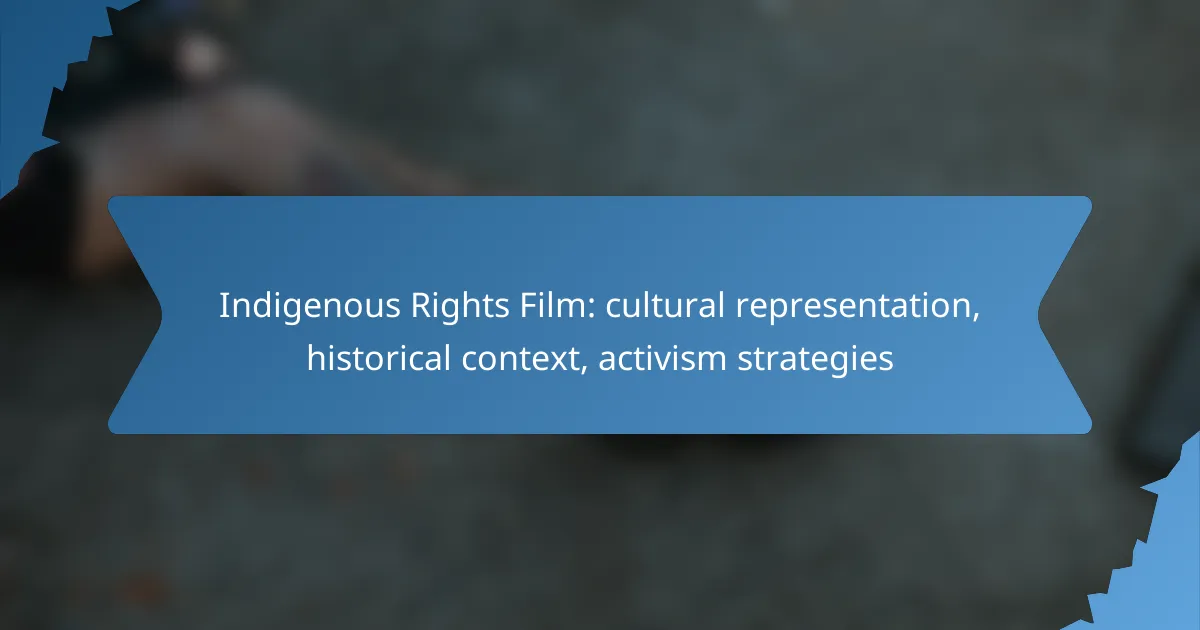Indigenous rights films in the UK are essential for enhancing cultural representation and educating audiences about the histories and experiences of Indigenous communities. By navigating the complex historical context of colonial narratives, these films not only challenge stereotypes but also empower Indigenous voices. Through diverse activism strategies, such as grassroots mobilization and social media engagement, they advocate for the rights and recognition of Indigenous peoples.
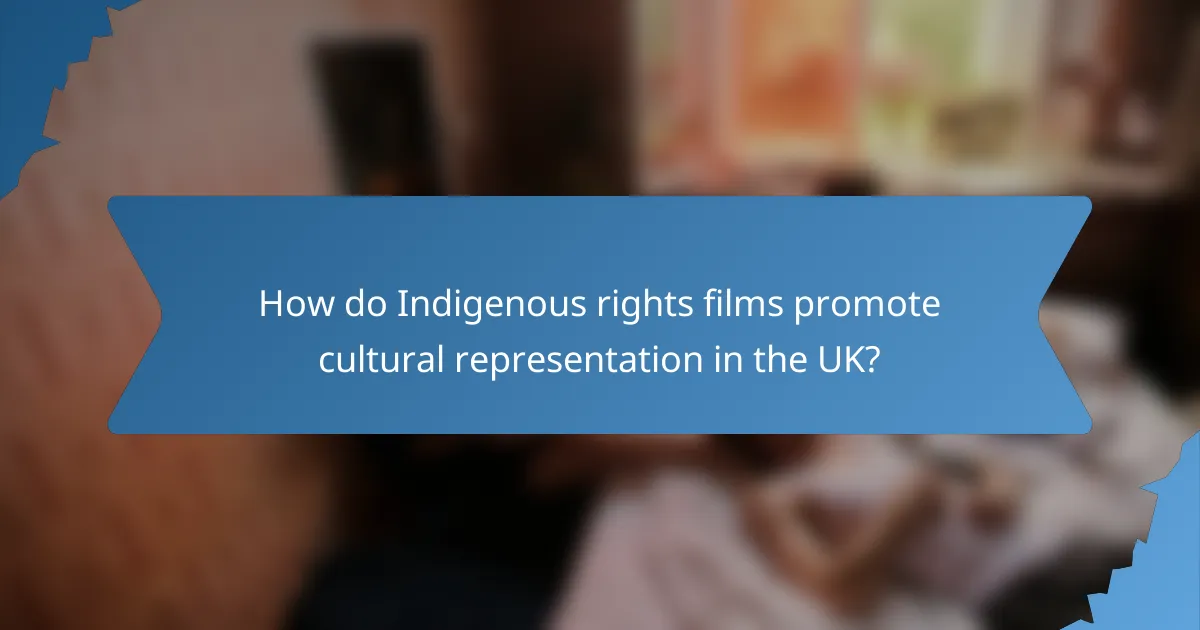
How do Indigenous rights films promote cultural representation in the UK?
Indigenous rights films in the UK play a crucial role in promoting cultural representation by amplifying the voices and stories of Indigenous communities. These films serve as a platform to educate audiences about Indigenous histories, challenges, and triumphs, fostering greater understanding and respect.
Highlighting Indigenous narratives
Indigenous rights films often center on the personal and collective stories of Indigenous peoples, showcasing their unique experiences and perspectives. By focusing on these narratives, filmmakers can challenge stereotypes and provide a more nuanced understanding of Indigenous identities.
For example, films may explore themes of land rights, cultural preservation, and the impact of colonization, allowing viewers to engage with the realities faced by Indigenous communities. This storytelling approach not only informs but also resonates emotionally with audiences, promoting empathy and awareness.
Showcasing traditional practices
These films frequently highlight traditional practices, such as ceremonies, art forms, and languages, which are vital to Indigenous cultures. By documenting and presenting these practices, filmmakers help preserve cultural heritage and educate viewers about their significance.
For instance, a film might depict a traditional dance or craft, illustrating the skills and knowledge passed down through generations. This representation not only honors Indigenous traditions but also encourages appreciation and respect from wider audiences.
Featuring Indigenous filmmakers
Indigenous rights films are often created by Indigenous filmmakers, which ensures authenticity in storytelling and representation. These filmmakers bring their lived experiences and cultural insights to their work, enriching the narratives presented on screen.
Supporting Indigenous filmmakers is essential for fostering a diverse film industry. Initiatives such as funding programs and film festivals dedicated to Indigenous cinema can help promote these voices, ensuring that Indigenous perspectives are not only heard but celebrated within the broader cultural landscape.

What is the historical context of Indigenous rights in film?
The historical context of Indigenous rights in film is rooted in the complex interplay between colonial narratives and the representation of Indigenous peoples. Over time, films have both perpetuated stereotypes and provided platforms for Indigenous voices, reflecting broader societal changes and activism.
Colonial impact on representation
Colonialism has significantly influenced the representation of Indigenous peoples in film, often depicting them through a lens of stereotypes and misconceptions. Early films typically portrayed Indigenous characters as either noble savages or violent antagonists, reinforcing harmful narratives that marginalized their cultures.
This misrepresentation has led to a long-lasting impact on public perception and understanding of Indigenous identities, making it crucial for contemporary filmmakers to challenge these outdated portrayals and strive for authenticity.
Evolution of Indigenous storytelling
Indigenous storytelling has evolved from oral traditions to include film as a medium for cultural expression and activism. Filmmakers from Indigenous communities are increasingly reclaiming their narratives, using film to share authentic stories that reflect their lived experiences and cultural heritage.
This shift not only empowers Indigenous voices but also educates wider audiences about the richness and diversity of Indigenous cultures, fostering a deeper understanding and respect for their histories.
Key historical milestones
Several key milestones have marked the progress of Indigenous rights in film. The 1970s saw the emergence of Indigenous filmmakers who began to challenge mainstream narratives, such as the work of Alanis Obomsawin, whose films highlighted Indigenous issues in Canada.
In recent years, films like “Smoke Signals” and “The Fast Runner” have gained international recognition, showcasing Indigenous stories and perspectives. These milestones reflect a growing movement towards inclusivity and representation in the film industry, paving the way for future generations of Indigenous filmmakers.
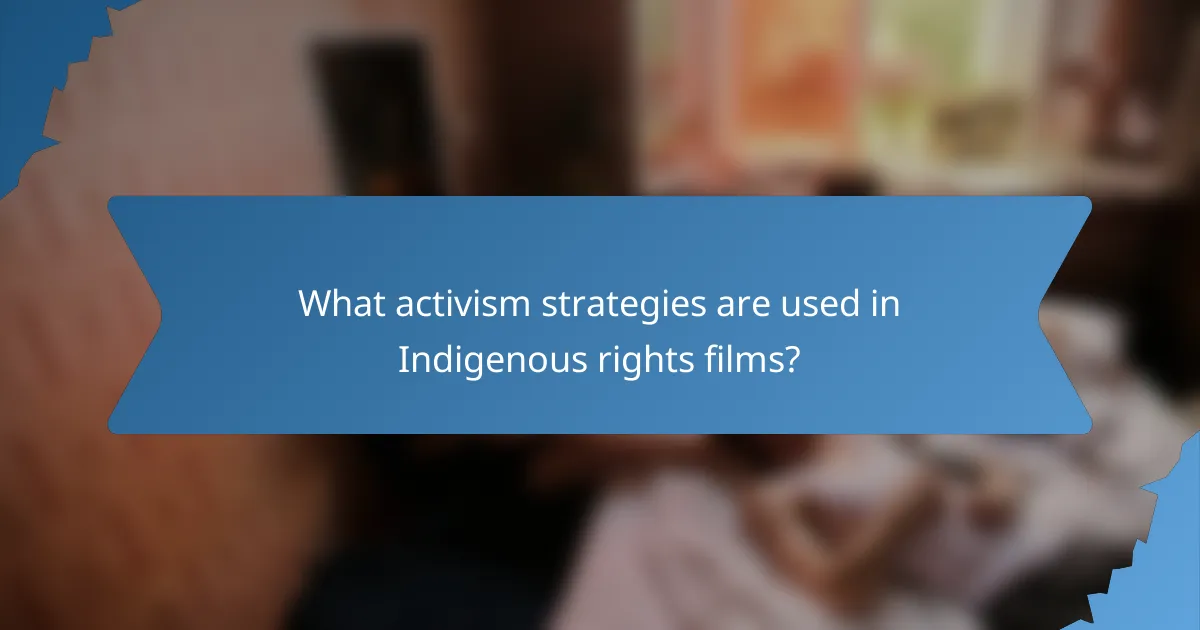
What activism strategies are used in Indigenous rights films?
Indigenous rights films employ various activism strategies to raise awareness and advocate for the rights of Indigenous peoples. These strategies often include grassroots mobilization, collaborative projects with communities, and the effective use of social media platforms to amplify their messages.
Grassroots mobilization
Grassroots mobilization involves engaging local communities to participate actively in advocacy efforts. This strategy often includes organizing events, workshops, and screenings that encourage community involvement and dialogue about Indigenous rights issues.
By fostering a sense of ownership among community members, grassroots mobilization can lead to stronger collective action. Filmmakers may collaborate with local leaders to ensure that the narratives presented resonate with the community’s experiences and aspirations.
Collaborative projects with communities
Collaborative projects with communities focus on co-creating content that reflects Indigenous perspectives and stories. Filmmakers often work closely with Indigenous groups to ensure authenticity and cultural sensitivity in their narratives.
These partnerships can take various forms, such as co-producing films, conducting interviews, or facilitating workshops. This approach not only empowers communities but also helps to preserve traditional knowledge and cultural heritage.
Utilizing social media platforms
Social media platforms are powerful tools for spreading awareness and mobilizing support for Indigenous rights. Filmmakers can share trailers, behind-the-scenes content, and personal stories that resonate with a broader audience.
Effective use of hashtags and campaigns can amplify the reach of these films, engaging users in discussions about Indigenous issues. Filmmakers should consider creating interactive content that encourages viewers to share their own experiences and perspectives, fostering a sense of community online.
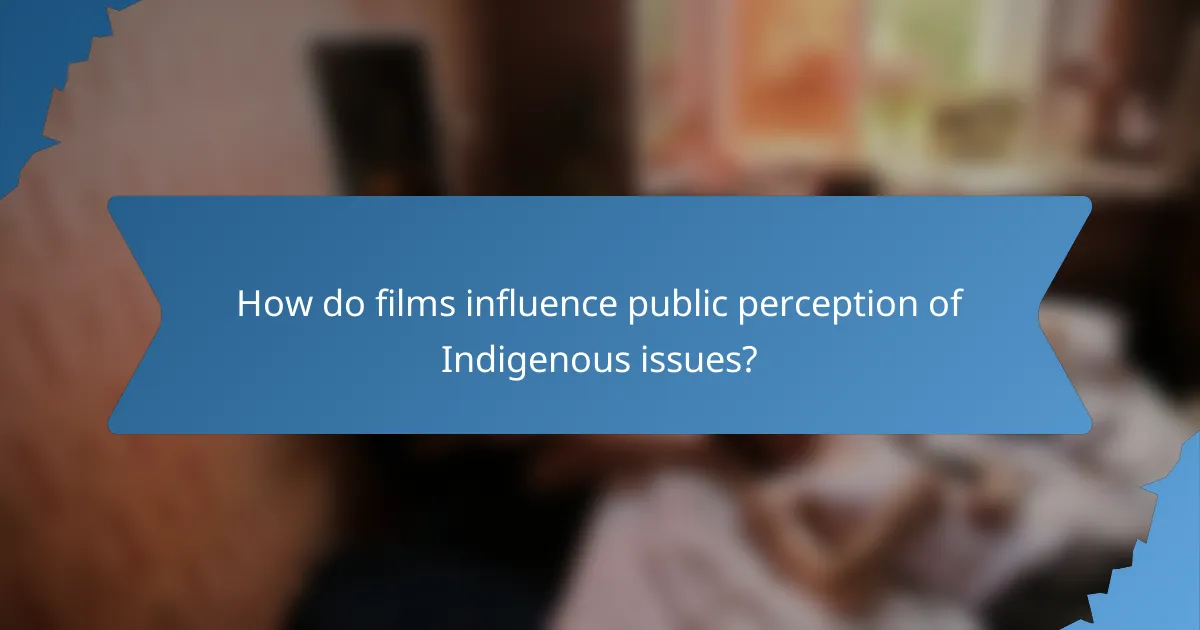
How do films influence public perception of Indigenous issues?
Films significantly shape public perception of Indigenous issues by presenting narratives that highlight cultural representation, historical context, and activism strategies. They serve as powerful tools for educating audiences and fostering empathy, ultimately influencing societal attitudes and beliefs.
Shaping narratives through visual storytelling
Visual storytelling in films allows for the portrayal of Indigenous cultures and histories in a compelling manner. By using authentic voices and perspectives, filmmakers can challenge stereotypes and provide a more nuanced understanding of Indigenous experiences. For instance, documentaries that feature Indigenous leaders discussing their traditions can foster respect and appreciation among viewers.
Moreover, films can highlight the struggles faced by Indigenous communities, such as land rights and cultural preservation. This narrative approach not only informs audiences but also encourages them to engage with these issues on a deeper level.
Engaging audiences in dialogue
Films can spark conversations about Indigenous rights and representation, creating a platform for dialogue among diverse audiences. Screenings often include discussions or Q&A sessions with filmmakers and Indigenous representatives, allowing viewers to ask questions and gain insights directly from those affected by the issues portrayed.
Additionally, social media campaigns tied to film releases can amplify these discussions, encouraging viewers to share their thoughts and experiences. This engagement can lead to a greater understanding of Indigenous perspectives and foster solidarity with their causes.
Impact on policy discussions
Films can influence policy discussions by raising awareness about Indigenous issues among policymakers and the general public. When a film gains traction, it can lead to increased media coverage, which in turn puts pressure on government officials to address the highlighted concerns. For example, documentaries that expose injustices faced by Indigenous communities can prompt legislative reviews or reforms.
Furthermore, successful films can mobilize grassroots activism, encouraging viewers to advocate for policy changes. This can include signing petitions, attending rallies, or engaging with local representatives to push for the rights and recognition of Indigenous peoples.
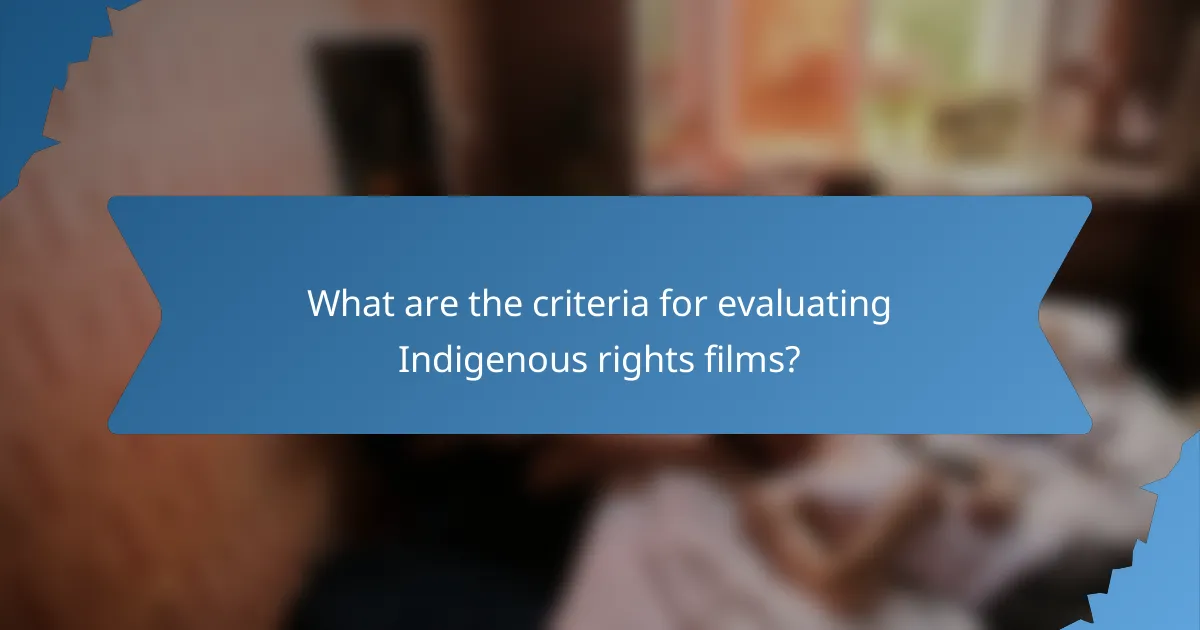
What are the criteria for evaluating Indigenous rights films?
Evaluating Indigenous rights films involves assessing their authenticity, community engagement, and artistic merit. These criteria help determine how effectively a film represents Indigenous experiences and contributes to activism.
Authenticity of representation
Authenticity in representation is crucial for Indigenous rights films, as it ensures that the narratives reflect genuine Indigenous experiences and perspectives. This can be evaluated by examining the accuracy of cultural depictions, language use, and adherence to traditional practices.
Films should avoid stereotypes and instead portray the complexity of Indigenous identities. Engaging with cultural consultants or Indigenous filmmakers can enhance authenticity and provide a more nuanced understanding of the issues faced by Indigenous communities.
Engagement with Indigenous communities
Effective Indigenous rights films actively engage with the communities they represent. This includes involving community members in the filmmaking process, from script development to casting and production. Such collaboration fosters trust and ensures that the film aligns with the community’s values and goals.
Producers should seek feedback from Indigenous audiences during screenings and incorporate their insights into the final product. This approach not only enriches the film but also empowers the community by giving them a voice in how their stories are told.
Artistic merit and impact
Artistic merit refers to the film’s overall quality, including storytelling, cinematography, and direction. A film that excels in these areas can effectively convey its message and resonate with a broader audience, thereby increasing its impact on Indigenous rights advocacy.
When evaluating impact, consider how the film influences public perception and awareness of Indigenous issues. Successful films often spark discussions, inspire activism, and lead to tangible changes in policy or community support. Assessing audience engagement and critical reception can provide insights into the film’s effectiveness in promoting Indigenous rights.
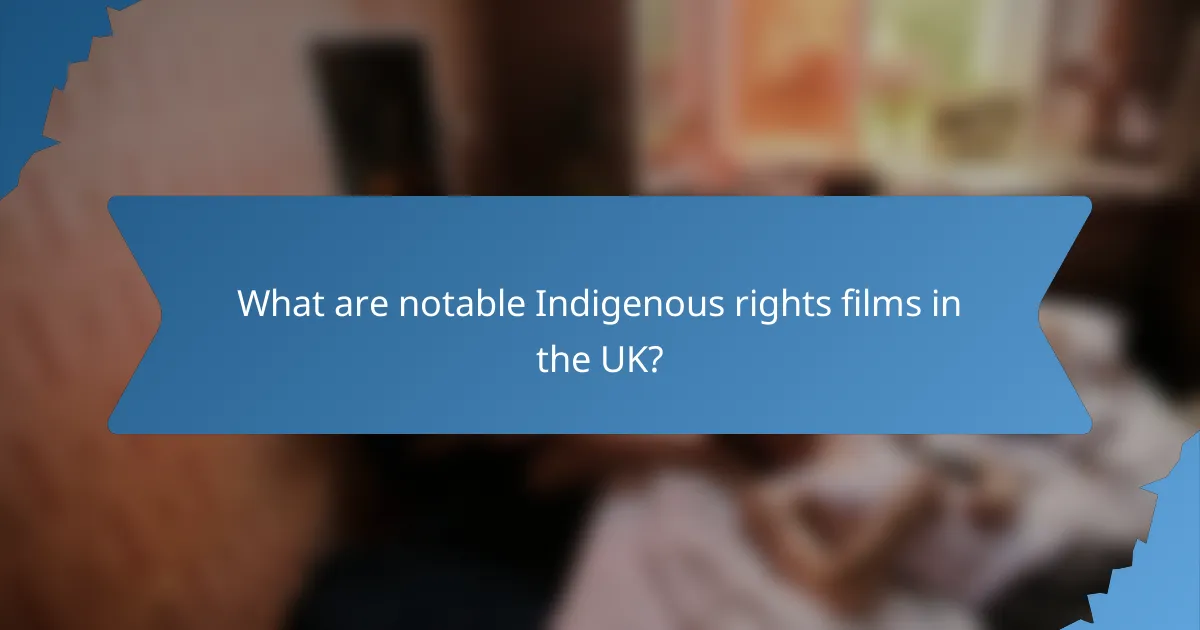
What are notable Indigenous rights films in the UK?
Notable Indigenous rights films in the UK highlight the struggles and triumphs of Indigenous communities, focusing on cultural representation, historical context, and activism strategies. These films often serve as powerful tools for advocacy and education, raising awareness about the rights and issues faced by Indigenous peoples.
Cultural Representation
Cultural representation in Indigenous rights films is crucial for authentic storytelling. These films often showcase the rich traditions, languages, and histories of Indigenous communities, allowing viewers to gain a deeper understanding of their cultures. For example, films like “The Last Tree” explore themes of identity and belonging, reflecting the experiences of Indigenous individuals in contemporary society.
Historical Context
Understanding the historical context of Indigenous rights is essential for grasping the narratives presented in these films. Many films delve into the impact of colonization, land dispossession, and cultural erasure on Indigenous peoples. Documentaries such as “In the Land of the Free” highlight historical injustices while connecting them to present-day activism and rights movements.
Activism Strategies
Indigenous rights films often showcase various activism strategies employed by communities to advocate for their rights. These strategies can include grassroots organizing, legal challenges, and public awareness campaigns. Films like “We Are Many” illustrate how collective action and storytelling can mobilize support for Indigenous causes, encouraging viewers to engage in advocacy efforts themselves.
